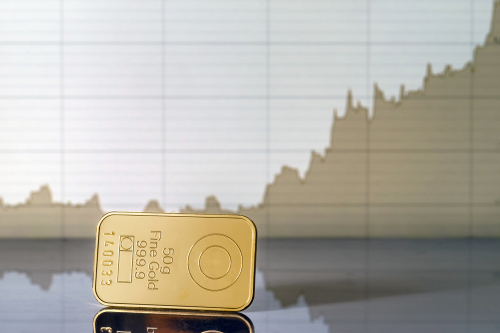
What makes gold a strategic asset?
Gold benefits from diverse sources of demand: as an investment, a reserve asset, a luxury good and a technology component. It is highly liquid, no one’s liability, carries no credit risk, and is scarce, historically preserving its value over time.
Gold can enhance a portfolio in four key ways:
- generate long-term returns (Chart 3)
- act as a diversifier and mitigate losses in times of market stress (Chart 6)
- provide liquidity with no credit risk (Chart 7)
- improve overall portfolio performance. (Chart 8)
Our analysis illustrates that adding between 3% and 11% in gold to an average European investor’s portfolio over the past decade would have resulted in higher risk-adjusted returns.2
New decade, renewed challenges
European investors have seen turbulent times in the last decade. The sovereign debt crisis which immediately followed the Global Financial Crisis highlighted the need for robust risk management. As a new decade has begun, investors face an expanding list of challenges around asset management and portfolio construction.1
Persistent ultra-low interest rates
European investors have had to endure low and negative interest rates since the Global Financial Crisis. As with previous crises, and more recently the onset of COVID-19, policy makers continue to navigate their way through by keeping rates low in order to support economic growth. But low interest rates can push investors to seek out riskier assets at elevated valuation levels to achieve higher returns. Persistently low interest rates also reduce the opportunity cost of holding gold and highlight its attributes as a source of genuine, long-term returns – particularly when compared to historically high levels of global negative-yielding debt – and provide much needed diversification.
The impact of loose monetary policy could also lead to unintended consequences on asset performance and distort asset allocations for years to come. Additionally, widespread fiscal stimuli and ballooning government debt are raising concerns about a long-term run up of inflation.
Trade tensions and geopolitical uncertainty
Investors in the region are faced with several geopolitical risks, both local and global. The uncertainty and volatility, both financially and politically, caused by the UK’s decision to leave the European Union (“Brexit”) has posed a serious risk to investor portfolios. Beyond this, a deterioration of relations between the US and China, as well as greater levels of protectionism and trade tensions presents a significant threat to global demand This adds up to a very real risk for European economies, with Germany, France, the Netherlands, and Italy in the top 10 exporting nations globally.3
ESG considerations
Environmental, social and governance (ESG) issues are now decisive in shaping asset selection or strategies. According to Mercer, 89% of European investors now take ESG factors into account when choosing investments.4 This is in line with wider societal expectations but also driven by a host of legal and regulatory changes. The moves towards an increased understanding of this wider set of risks, and actions to mitigate their negative impacts, has also been a key factor in shaping the evolution of the gold supply chain, as well as gold’s developing role as a climate-change risk mitigation asset.5
The role of gold
Investors in Europe have long recognised the benefits of gold. Per capita gold consumption in Germany and Switzerland is among the highest in the world.6 However, institutional investors also stand to benefit from allocating a proportion of their portfolio to gold. In today’s environment, we believe that gold has an increasingly relevant role to play in helping European investors tackle the risk and uncertainty that lies ahead.
David